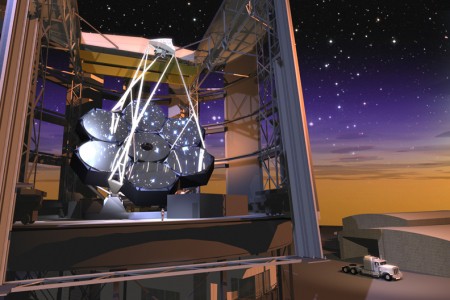
The prospect of a ground-based telescope that can directly see extrasolar planets, the earliest stellar systems and the birth of distant galaxies is nearing reality. The Gordon and Betty Moore Foundation has pledged $200m for the design and construction of the Thirty Metre Telescope (TMT), which is being developed by a consortium of astronomers in the US and Canada, including the California Institute of Technology and the University of California.
“I feel very proud of the team that is carrying out the design of TMT, and I’m grateful for the generosity of the Moore Foundation and the TMT partners,” said Gary Sanders, project manager of the TMT. “With this lead commitment to construction funding, we can confidently complete the TMT design and plan to initiate construction according to our plan.”
As its name suggests, the TMT will consist of a mirror 30 m in diameter, giving it eight times the collecting area of any current telescope. But unlike conventional telescopes, the size of the mirror means that it will have to be split up into 492 individual hexagonal segments, all packed together into a curved honeycomb arrangement. Furthermore, it will need a complex system to correct for distortion of light in the atmosphere, shining six laser beams onto fixed points in the sky to assess the amount of turbulence.
The $200m donation from the Moore Foundation, which was set up by the co-founder of Intel Corporation and his wife, will be spread over nine years. The cash will be added to gifts from the California Institute of Technology and the University of California, bringing the total funding of the TMT to $300m — enough to allow astronomers to finish developing the telescope and start building it in April 2009. The TMT is expected to be completed in late 2016, although before then the consortium will have to raise the rest of the estimated $700m building costs.
Not alone
In the same year, astronomers might see the completion of a rival giant telescope being developed by eight US institutions and the Australian National University. With an equivalent resolving diameter of 24.5 m, The Giant Magellan Telescope (GMT) may be slightly smaller than the TMT, but it has already selected its construction site in central Chile and is presently polishing the first of its seven petal-like mirrors. Although the GMT is now lagging behind in terms of funding having raised around $35m of its required $550, Wendy Freedman, leader of the GMT board, insists that the GMT project is just as likely to go ahead. “Our partners are also actively engaged in raising significant funding,” she told physicsworld.com. “The Moore gift, and the seriousness with which these big projects are being taken, is exciting for all of astronomy.”
The European Organisation for Astronomical Research in the Southern Hemisphere (ESO) is thinking even bigger. It is expecting to start building a 40-m telescope called the European Extremely Large Telescope (E-ELT) in three years’ time, and has a 60 to 100-m telescope known as the Overwhelmingly Large Telescope (OWL) in the pipeline.




